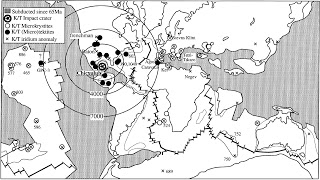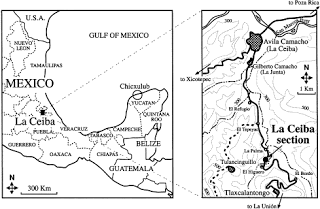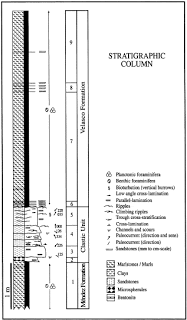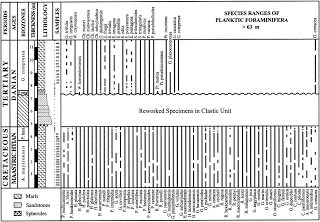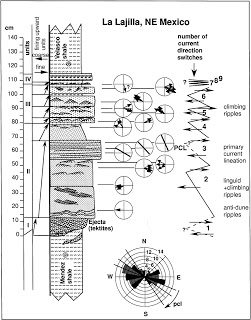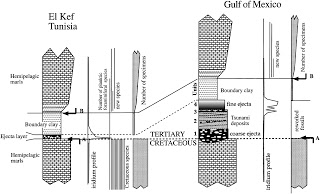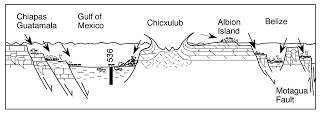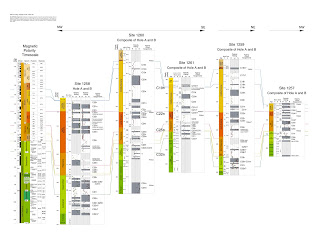8.4: Chronostratigraphy
- Page ID
- 224
\( \newcommand{\vecs}[1]{\overset { \scriptstyle \rightharpoonup} {\mathbf{#1}} } \)
\( \newcommand{\vecd}[1]{\overset{-\!-\!\rightharpoonup}{\vphantom{a}\smash {#1}}} \)
\( \newcommand{\dsum}{\displaystyle\sum\limits} \)
\( \newcommand{\dint}{\displaystyle\int\limits} \)
\( \newcommand{\dlim}{\displaystyle\lim\limits} \)
\( \newcommand{\id}{\mathrm{id}}\) \( \newcommand{\Span}{\mathrm{span}}\)
( \newcommand{\kernel}{\mathrm{null}\,}\) \( \newcommand{\range}{\mathrm{range}\,}\)
\( \newcommand{\RealPart}{\mathrm{Re}}\) \( \newcommand{\ImaginaryPart}{\mathrm{Im}}\)
\( \newcommand{\Argument}{\mathrm{Arg}}\) \( \newcommand{\norm}[1]{\| #1 \|}\)
\( \newcommand{\inner}[2]{\langle #1, #2 \rangle}\)
\( \newcommand{\Span}{\mathrm{span}}\)
\( \newcommand{\id}{\mathrm{id}}\)
\( \newcommand{\Span}{\mathrm{span}}\)
\( \newcommand{\kernel}{\mathrm{null}\,}\)
\( \newcommand{\range}{\mathrm{range}\,}\)
\( \newcommand{\RealPart}{\mathrm{Re}}\)
\( \newcommand{\ImaginaryPart}{\mathrm{Im}}\)
\( \newcommand{\Argument}{\mathrm{Arg}}\)
\( \newcommand{\norm}[1]{\| #1 \|}\)
\( \newcommand{\inner}[2]{\langle #1, #2 \rangle}\)
\( \newcommand{\Span}{\mathrm{span}}\) \( \newcommand{\AA}{\unicode[.8,0]{x212B}}\)
\( \newcommand{\vectorA}[1]{\vec{#1}} % arrow\)
\( \newcommand{\vectorAt}[1]{\vec{\text{#1}}} % arrow\)
\( \newcommand{\vectorB}[1]{\overset { \scriptstyle \rightharpoonup} {\mathbf{#1}} } \)
\( \newcommand{\vectorC}[1]{\textbf{#1}} \)
\( \newcommand{\vectorD}[1]{\overrightarrow{#1}} \)
\( \newcommand{\vectorDt}[1]{\overrightarrow{\text{#1}}} \)
\( \newcommand{\vectE}[1]{\overset{-\!-\!\rightharpoonup}{\vphantom{a}\smash{\mathbf {#1}}}} \)
\( \newcommand{\vecs}[1]{\overset { \scriptstyle \rightharpoonup} {\mathbf{#1}} } \)
\( \newcommand{\vecd}[1]{\overset{-\!-\!\rightharpoonup}{\vphantom{a}\smash {#1}}} \)
\(\newcommand{\avec}{\mathbf a}\) \(\newcommand{\bvec}{\mathbf b}\) \(\newcommand{\cvec}{\mathbf c}\) \(\newcommand{\dvec}{\mathbf d}\) \(\newcommand{\dtil}{\widetilde{\mathbf d}}\) \(\newcommand{\evec}{\mathbf e}\) \(\newcommand{\fvec}{\mathbf f}\) \(\newcommand{\nvec}{\mathbf n}\) \(\newcommand{\pvec}{\mathbf p}\) \(\newcommand{\qvec}{\mathbf q}\) \(\newcommand{\svec}{\mathbf s}\) \(\newcommand{\tvec}{\mathbf t}\) \(\newcommand{\uvec}{\mathbf u}\) \(\newcommand{\vvec}{\mathbf v}\) \(\newcommand{\wvec}{\mathbf w}\) \(\newcommand{\xvec}{\mathbf x}\) \(\newcommand{\yvec}{\mathbf y}\) \(\newcommand{\zvec}{\mathbf z}\) \(\newcommand{\rvec}{\mathbf r}\) \(\newcommand{\mvec}{\mathbf m}\) \(\newcommand{\zerovec}{\mathbf 0}\) \(\newcommand{\onevec}{\mathbf 1}\) \(\newcommand{\real}{\mathbb R}\) \(\newcommand{\twovec}[2]{\left[\begin{array}{r}#1 \\ #2 \end{array}\right]}\) \(\newcommand{\ctwovec}[2]{\left[\begin{array}{c}#1 \\ #2 \end{array}\right]}\) \(\newcommand{\threevec}[3]{\left[\begin{array}{r}#1 \\ #2 \\ #3 \end{array}\right]}\) \(\newcommand{\cthreevec}[3]{\left[\begin{array}{c}#1 \\ #2 \\ #3 \end{array}\right]}\) \(\newcommand{\fourvec}[4]{\left[\begin{array}{r}#1 \\ #2 \\ #3 \\ #4 \end{array}\right]}\) \(\newcommand{\cfourvec}[4]{\left[\begin{array}{c}#1 \\ #2 \\ #3 \\ #4 \end{array}\right]}\) \(\newcommand{\fivevec}[5]{\left[\begin{array}{r}#1 \\ #2 \\ #3 \\ #4 \\ #5 \\ \end{array}\right]}\) \(\newcommand{\cfivevec}[5]{\left[\begin{array}{c}#1 \\ #2 \\ #3 \\ #4 \\ #5 \\ \end{array}\right]}\) \(\newcommand{\mattwo}[4]{\left[\begin{array}{rr}#1 \amp #2 \\ #3 \amp #4 \\ \end{array}\right]}\) \(\newcommand{\laspan}[1]{\text{Span}\{#1\}}\) \(\newcommand{\bcal}{\cal B}\) \(\newcommand{\ccal}{\cal C}\) \(\newcommand{\scal}{\cal S}\) \(\newcommand{\wcal}{\cal W}\) \(\newcommand{\ecal}{\cal E}\) \(\newcommand{\coords}[2]{\left\{#1\right\}_{#2}}\) \(\newcommand{\gray}[1]{\color{gray}{#1}}\) \(\newcommand{\lgray}[1]{\color{lightgray}{#1}}\) \(\newcommand{\rank}{\operatorname{rank}}\) \(\newcommand{\row}{\text{Row}}\) \(\newcommand{\col}{\text{Col}}\) \(\renewcommand{\row}{\text{Row}}\) \(\newcommand{\nul}{\text{Nul}}\) \(\newcommand{\var}{\text{Var}}\) \(\newcommand{\corr}{\text{corr}}\) \(\newcommand{\len}[1]{\left|#1\right|}\) \(\newcommand{\bbar}{\overline{\bvec}}\) \(\newcommand{\bhat}{\widehat{\bvec}}\) \(\newcommand{\bperp}{\bvec^\perp}\) \(\newcommand{\xhat}{\widehat{\xvec}}\) \(\newcommand{\vhat}{\widehat{\vvec}}\) \(\newcommand{\uhat}{\widehat{\uvec}}\) \(\newcommand{\what}{\widehat{\wvec}}\) \(\newcommand{\Sighat}{\widehat{\Sigma}}\) \(\newcommand{\lt}{<}\) \(\newcommand{\gt}{>}\) \(\newcommand{\amp}{&}\) \(\definecolor{fillinmathshade}{gray}{0.9}\)The idea behind chronostratigraphy is to correlate rocks that formed at the same time. This is useful for reconstructing events and depositional environments in earth history as well as finding resources like oil. There are several techniques that can be used for chronostratigraphy, including: event stratigraphy, magnetostratigraphy, chemostratigraphy, biostratigraphy, and sequence stratigraphy. Here, I will address event stratigraphy, magnetostratigraphy, and biostratigraphy. Sequence stratigraphy is very powerful, and lots of resources on it can be found at: http://sepmstrata.org/
Event Stratigraphy
Event stratigraphy involves identifying the sedimentary effects of an unusual event in multiple stratigraphic columns. If one can demonstrate the the effects were all produced by the same even, one can reasonably interpret the effects to have happened at the same time in the different columns. For example, if a volcano erupts and deposits ash over a broad region, that ash is preserved in the stratigraphy, and a geologist can demonstrate that the ash in multiple sections came from the same eruption, then the geologist can create a chronostratigraphic correlation among the sections. Other events that are useful for event stratigraphy can include impact debris layers (for example at the Cretaceous-Tertiary boundary), tsunami deposits, and sometimes large storms.
There are some shortcomings of event stratigraphy. First, there has to be an event that affects the stratigraphy. For it to be useful, it needs to be something that affects multiple depositional environments in a way that produces a distinctive set of features that can be distinguished from the normal depositional processes. Second, for a specific event to be useful for correlations, it has to have affected the stratigraphy at the sites of interest. For example, a tsunami that affected the west coast of North America might help one correlate Pleistocene coastal deposits in Oregon and Washington. However, it would not be helpful for correlating Pleistocene rocks in Florida because it did not influence them. Third, if there are multiple events, the geologist has to sort out which correlate with each other. For example, if there are multiple volcanic eruptions at different times, the geologist needs to evaluate which eruptions the ash beds might represent. It can become complicated to correlate many events. Sometimes correlations are more reliable if there are fewer events, but then there are not as many potential temporal ties between the stratigraphic columns. Even with these complications, event stratigraphy is a very valuable tool. When the events are volcanic, the ash beds can often be dated, providing a precise age for a segment of the stratigraphic column.
Magnetostratigraphy
Magnetostratigraphy uses preserved magnetization of rocks for correlation. The magnetization comes from the alignment of magnetic minerals in sedimentary rocks (and other types of rocks) with the earth’s magnetic field. Small magnetic minerals, especially clay-sized minerals, align like little magnets, and when the sediment is lithified, that magnetization can be preserved. Under the right conditions, samples can be collected and the direction of magnetization measured. Data can be used to reconstruct the direction of the earth’s magnetic field. This magnetic field can reverse directions due to the dynamics of circulation in the core. In other words, sometimes the magnetic field is aligned such that magnets point north (as they do now, and called “normal” in the scientific literature) and sometimes it is aligned such that magnets point south (called “reversed”). The earth’s magnetic field changes at close to the same time globally, so the effects are seen everywhere. Paleomagnetists have studied well dated sedimentary and volcanic rocks and have mapped out the times in earth history where the magnetic field was normal and reversed (see: http://www.geosociety.org/science/timescale/). This provides a reference that can help correlate other stratigraphic sections.
To correlate a suite of stratigraphic sections using magnetostratigraphy, one would collect samples, measure their magnetic properties using a variety of techniques, and evaluate whether or not they have been remagnetized. If they have not been remagnetized, changes in the direction of earth’s magnetic field can often be interpreted from the results. If a geologist has multiple sections that were deposited at the same time, they can interpret the changes in the direction of earth’s magnetic field to have happened at the same time. Unfortunately, however, one can not necessarily independently tell the many normal intervals apart from each other nor the many reversed intervals apart. Thus, the geologist needs additional information to make reliable chronostratigraphic correlations.
Biostratigraphy
Biostratigraphy is an extremely powerful tool for chronostratigraphic correlation. Life evolves through time, with new species emerging and other species going extinct. For time intervals and species that are well studied, the process of evolution provides a detailed temporal framework for correlating stratigraphic columns. The basic idea is for the geologist to identify fossils in the stratigraphic columns, compare them to the ranges of those organisms know from previous studies, and then interpret the age of the rocks from documented extinction and species origination events. This is an extremely powerful approach to correlating stratigraphic columns because each species is unique and changes through time. However, not all organisms are useful for biostratigraphy.
- have short geological ranges, e.g. they did not live for millions of years, and evolved quickly;
- were distributed over a large region of the earth;
- were easily preserved; and
- were abundant. They also need to be well studied.
Zones of well documented species with distinct origination and extinction times can be defined a number of ways. A zone could consist of the total time of existence of a fossil, it could consist of the time where two or more fossils coexist, it could be defined as the time between the origination of one fossil and the extinction of a different fossil, etc. An example of a biostratigraphic zone chart, combined with magnetostratigraphic reversals can be found at: http://www-odp.tamu.edu/publications/189_IR/chap_02/c2_f6.htm
Cretaceous-Tertiary Boundary Example
The end of Cretaceous time is marked by a major extinction, a meteorite impact, and reversals in the Earth's magnetic field. The following are some figures we'll use in class. I'll update the notes and reference the figures after class (my computer just crashed and I lost what I'd written - save often!)
Contributors
- Dawn Sumner (Department of Earth and Planetary Sciences, UC Davis)




